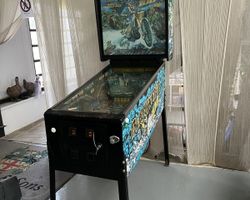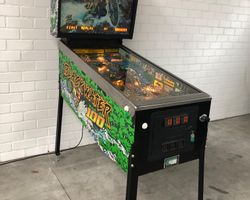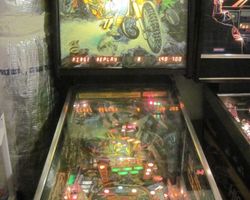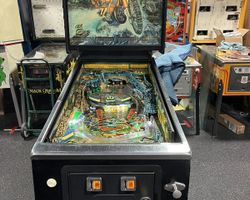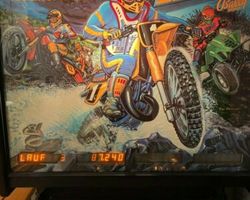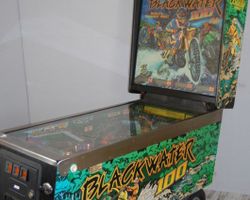Blackwater 100
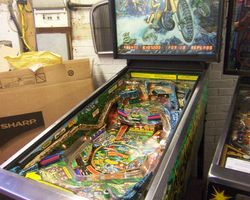
Average Prices: USD $500 to $2,400
Produced: March, 1988
Production Run: 3,000 units
Machine Type: Solid State Electronic
MPU: Bally MPU A084-91786-AH06 (6803)
Players: 4
Design by: Dennis Nordman
Art by: Tony Ramunni
Sound by: Neil Falconer, Greg Freres, Dennis Nordman
Software by: Gary Oglesby
Released in March 1988 by Bally Manufacturing Co., Blackwater 100 emerged as a distinctive entry in the world of solid-state pinball. This machine drew its inspiration from the rugged, adrenaline-fueled world of off-road motorcycle racing, specifically named after a challenging and well-known endurance race. The game was conceived and brought to life by a notable team: Dennis Nordman handled the design, Tony Ramunni crafted the artwork, Gary Oglesby developed the software, and Neil Falconer composed the sound. Nordman himself cited Bally Midway's 1988 arcade title "Escape from the Lost World" as an inspiration for Blackwater 100, and he, along with Greg Freres, even embarked on a field trip to record authentic sounds for the game, aiming to capture the essence of the real race experience.
Blackwater 100 holds a unique position in pinball history for several reasons. With a production run of 3,000 units, it was the last game introduced by Bally before the company’s acquisition by WMS Industries Inc., marking the end of an era for Bally as an independent pinball manufacturer. Furthermore, it is recognized as the first solid-state pinball machine to incorporate a "Buy-In" feature, allowing players to extend their game with an additional credit, a mechanic that would later become common in the industry. The machine also featured an innovative backbox design, utilizing an orange plexiglass top instead of traditional wood, with flashers underneath that could illuminate the ceiling, creating an engaging visual effect.
Signature Features and Design
Blackwater 100 stands apart with its bold design choices, most notably its multi-level playfield and a total of five flippers. The custom-shaped cabinet itself hinted at the unconventional layout within. Rather than a flat, single plane of action, the playfield is meticulously divided into three distinct areas of engagement, including an upper playfield and an additional elevated section positioned behind and above the main lower flippers, an area traditionally reserved for instruction cards. This upper-most section, referred to as the "Fast Line" or "backwards playfield," features its own flipper, creating a truly unique dynamic.
The game also eschewed traditional pop bumpers, a deliberate choice that contributes to its distinct playfield flow and shot strategies. The visual design is cohesive with the motocross theme, utilizing custom plastics and detailed artwork by Tony Ramunni that evoke the mud, grit, and speed of off-road racing. The display is an alphanumeric type, located near the bottom of the backglass, providing clear scoring and game information. The presence of three ramps, a high number for a machine of its era, further enhanced the sense of verticality and shot variety, inviting players to navigate complex paths for scoring.
Playfield and Mechanics
The playfield of Blackwater 100 is a masterclass in unconventional design, demanding a varied approach from players. The lower playfield serves as the primary action zone, featuring key targets such as the "Swamp" 5-bank drop targets and "Rapids" stand-up targets, both integral to completing sections of the race. Two prominent ramps, "Hwy 93" and "Hill Climb," provide distinct shot opportunities and contribute to the game's overall flow, often leading to distinct vocal callouts when successfully hit.
Above the main flippers, the upper playfield opens up a new dimension of play. This area includes targets labeled "Rocks," "Cliff Hanger," and "Bog," along with a central bumper. A spectacular "Downhill Ramp" is a defining feature here, feeding the ball down the playfield, then propelling it upwards again, ultimately landing it on the "backwards playfield." This multi-stage ramp shot is a visually impressive and strategically important element.
The backwards playfield, located at the very top of the machine, is a groundbreaking design element. Accessible via the Downhill Ramp, this small, elevated section contains targets and its own dedicated flipper. Shots made here, particularly the "Fast Line" shot, are crucial for advancing the Playfield Multiplier, which significantly boosts scoring during a "Heat." After interaction on this elevated area, the ball typically returns to the lower playfield, maintaining a continuous flow of action across the different levels. The artwork throughout the playfield, from the muddy tracks to the racing vehicles, immerses the player in the demanding environment of the Blackwater 100 race.
Gameplay Dynamics
Blackwater 100 defies traditional pinball structures by introducing "Heats" instead of conventional balls per game. Each game begins with three "Heats," and each Heat itself starts with a three-ball multiball. Players must load three balls into the "Starting Gate," initiating a countdown before all three are released into play. This unique starting mechanic immediately thrusts players into intense action. A "Buy-In" feature, a first for solid-state games, allows players to purchase additional "Heats" to extend their game, adding a layer of strategic decision-making beyond typical extra ball opportunities.
The core objective revolves around completing three "Laps," with each Lap comprising eight "Sections." These Sections are associated with lights corresponding to various playfield features, and progress carries over between Heats. A key gameplay mechanic is the "Flashing Section," where completing the currently flashing section awards bonus points and rotates to a new flashing section. Players can even manipulate which section is flashing using the green action buttons, adding a strategic layer to shot prioritization.
The "Bonus Multiplier" is another vital element, primarily increased by hitting targets on the backwards playfield. This multiplier, which can reach up to 4x, is applied to all scoring within the current Heat, making shots to the upper playfield and the Fast Line critical for high scores. After completing a full Lap, a "Special Test" becomes available. This challenging mode requires specific sequences of shots—draining all but one ball, hitting the Upper Saucer, then the Downhill Ramp, and finally the Lower Saucer—to score a substantial bonus and light the special award. Other features like "Save-It!" provide immediate rewards through specific loop shots or accurate Fast Line hits, reinforcing the game’s emphasis on precise play and flow.
Reception and Legacy
Blackwater 100 garnered a mixed but generally positive reception from the pinball community, a reflection of its unconventional design and gameplay. Many players celebrated its unique and creative approach, particularly praising the multi-level playfield and the bold decision to start each "Heat" with a three-ball multiball. The presence of five flippers and the "Downhill Ramp" were frequently highlighted as sources of fast-paced, challenging fun, allowing for trailblazing combo shots that reward skill and precision. The motocross theme was widely considered well-integrated, with custom plastics and sound design contributing to the sensation of being in an actual off-road race. Enthusiasts often found the game difficult to master, which, for many, translated into significant long-term replayability and a rewarding challenge.
However, some aspects of Blackwater 100 drew criticism. For a segment of players, the game’s unique mechanics, particularly the starting multiball and multiple playfield levels, felt somewhat gimmicky, suggesting the novelty might wear off quickly. The split playfields were occasionally seen as hindering natural flow, with the lower playfield orbit sometimes being too fast, leading to quick and frustrating drains. Concerns were also raised regarding build quality, specifically the durability of cabinet materials and certain plastics. The sound experience received notable critique, often described as "atrocious," "weak," or "tinny," a surprising point given the custom sound recording efforts. Furthermore, the machine's complexity and the potential for parts availability issues made it a higher-maintenance title for some collectors, while its fast-paced, demanding gameplay could be overwhelming for new players.
Despite its divisive elements, Blackwater 100 occupies a distinct space in pinball history. As the last machine from Bally before its acquisition, it represents a swansong for an era. Its pioneering "Buy-In" feature became a staple in subsequent pinball generations. The radical implementation of a multi-level playfield, including the "backwards" section, showcased a willingness to push design boundaries, influencing later games that experimented with verticality and alternative play areas. The "Heats" system, a departure from the traditional ball-per-game structure, was a bold design choice that, while not widely replicated, demonstrated a creative approach to game progression. Blackwater 100 remains a conversation piece among collectors, appreciated for its audacity and its unique contribution to the evolving design language of pinball machines.
Sponsored Links
 Ebay Listings
Ebay Listings
 Auction Results
Auction Results
| Cost | Location | Date |
|---|---|---|
| GBP £3,577 |  Banbury, United Kingdom Banbury, United Kingdom |
16 June, 2025 |
| USD $4,995 |  Connecticut, United States Connecticut, United States |
18 August, 2023 |
| USD $2,600 |  New York, United States New York, United States |
14 March, 2023 |
| USD $3,999 |  Florida, United States Florida, United States |
22 February, 2023 |
| USD $3,500 |  North Carolina, United States North Carolina, United States |
27 December, 2022 |
| USD $3,600 |  Virginia, United States Virginia, United States |
30 November, 2022 |
| EUR €3,000 |  Netherlands Netherlands |
01 October, 2022 |
| USD $5,000 |  Florida, United States Florida, United States |
27 July, 2022 |
| USD $3,500 |  Kansas, United States Kansas, United States |
10 June, 2022 |
| USD $3,000 |  Texas, United States Texas, United States |
08 January, 2022 |


Private Policy · Search Website · Contact Us
As an eBay Partner, we may earn a commission from qualifying purchases made through links on this site, at no additional cost to you.
All trademarks and copyrighted materials remain property of their respective owners. All other content copyright 2007 - 2025 Pinpedia.

